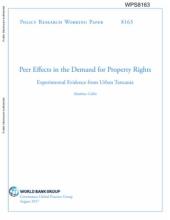Land Library
Bienvenue dans la bibliothèque du Land Portal. Explorez notre vaste collection de ressources en libre accès (plus de 74 000), comprenant des rapports, des articles scientifiques, des articles de recherche, des publications évaluées par des pairs, des documents juridiques, des vidéos et bien plus encore.
/ library resources
Showing items 1 through 9 of 811.This paper investigates the presence of endogenous peer effects in the adoption of formal property rights.
Secure land tenure in rural landscapes is widely recognized as an essential foundation for achieving a range of economic development goals. However, forest areas in low and middle-income countries face particular challenges in strengthening the security of land and resource tenure.
Following a chaotic political decolonization, from 1975 to 2000, the Comoros failed to sustain the extension of private land ownership pursued since the beginning of the twentieth century and to implement land reform prepared with the assistance of the FAO and the UNDP but abandoned after the ass
Many African countries rely on sporadic land transfers from customary to statutory domains to attract investment and improve agricultural performance. Data from 15,000 smallholders and 800 estates in Malawi allow exploring the long-term effects of such a strategy.
The role of land registration in reducing rural poverty has been debated for several decades.
Soil quality (SQ) assessment from farmers' point of view can be used as a primary indicator for planning sustainable agriculture.
Large-scale development projects often overlap forest areas that support the livelihoods of indigenous peoples, threatening in situ conservation strategies for the protection of biological and cultural diversity.
This study analyzes urban expansion and the peri-urban land tenure security situation in Amhara National Regional State of Ethiopia, taking Bahir Dar and Debre Markos as case studies.
In this paper, we ask what the effects of migration and remittances are on land tenure, agriculture and forests, based on empirical evidence from four rural communities in Guatemala.





